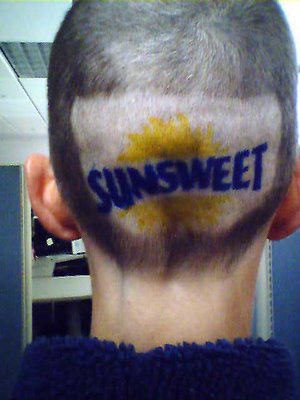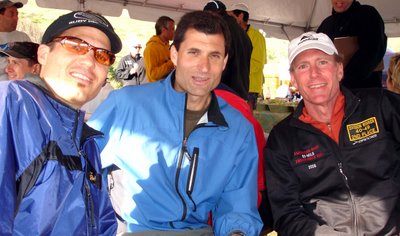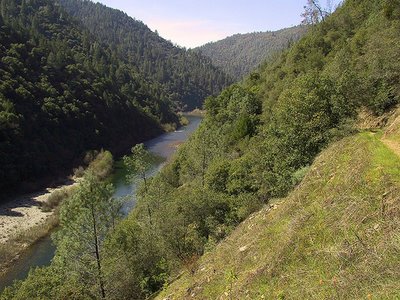Did you know there is a special
Western States belt buckle for 20-time finishers? So far only two runners have braved the tough 100-mile race for two decades -– founding runner Gordy Ainsleigh (20 finishes), and 25-time finisher and 5-time winner Tim Twietmeyer. Since 1981, Tim has been clocking sub-24 hour finishes at States, with a best of 16:51 (1994) and a Masters record of 17:17 in 2001. In 2005, he and
Dean Karnazes even finished the course in the dead of winter. Tim has also raced over 100 other ultras, and was the first ultrarunner to tour the 165-mile Tahoe Rim Trail in less than two days. Even with three teenage kids, a wife of 20 years, and a full-time product development manager job with Hewlett-Packard, Tim finds the time to train and consistently bring his "‘A"’ game to the starting line, no matter how much snow, hot canyons, or rain awaits him.
 (Tim Twietmeyer at the 2001 Western States)
(Tim Twietmeyer at the 2001 Western States)I caught up with Tim to hear about how the Western States has changed, share any tips, and see what is in his future.
From what I hear, you quickly went from "running"” to "running 100's" when you were still in your early 20'’s. The sport was so small then - how was it that you found this passion?
Just as I became a runner, I read some articles about Western States (WS). Those articles piqued my interest. One day after completing my work at the local country club (I worked as a caddy), I stopped by the local high school track to watch a 24-hour track race. That'’s what really hooked me. I got to watch some running legends like Dick Collins,
Ruth Anderson, Don Choi, and others. They made it look easy. I watched intently and tried to learn as much as I could from watching them. I was particularly fascinated by Dick Collins as he didn't look like a prototypical runner but he rarely left the track and accumulated a ton of miles. He was also very accommodating and answered all my questions (like "why are you eating that", "why did you change your shoes" and "what'’s with the bowl of aspirin on your crew table"). The next year (1979), while off between my junior and senior years of college, I ran my first ultra. That was my qualifier for WS (finishing a 50-miler) and that started me on my way to WS. I ran my first WS in 1981.
You'’ve probably seen a lot of changes in ultra running over the last two decades. How has it changed, and specifically for Western States?
The most noticeable difference is the advancement of equipment and knowledge to help everyone finish the race. Back in '81, the course wasn'’t marked until race day. Training on the course was a real problem. Now the trail is marked almost year-round, there'’s a three-day training camp to see the course, and the Web site has many years of split times and a ton of information on how to get through the race.
One other big change is the aid stations and the medical advancements to get a runner through the event. The aid stations have just about everything now including really good replacement drinks, gels, salty foods, and just about everything else. Back in the day, the aid stations had things like lemonade, tea, and ERG (which tasted really bad). Now we've got things like Succeed caps, E-caps, GU, and the ever-present boiled potato with salt.
What are your best and worst memories of Western States? Have you ever DNF'd?
By far my worst memory was 1982, my second year in the race. I'd finished in '81 in about 22 hours and had a good training season. Unfortunately, I goofed on the eating and drinking part of the race and got sick starting in Michigan Bluff and continuing all the way through Auburn Lake Trails. At one point I was down 11 pounds from my starting weight and spent over an hour lying in the aid station at White Oak Flat. I ended up finishing the race, but not after a very trying march from Green Gate to ALT. At one point I told my dad, who was pacing me, that if a motorcycle or horse came by on trail patrol I was done and I'd take a ride home. Thank goodness that ride never came.
My best memory at WS would be my first win in 1992. I'd finished 2nd, 3rd, and 4th the previous three years, so it didn'’t look like I was heading in the right direction to win the race. In 1992 everything came together and I was able to break through and win the race. It was also the fastest time I'’d run on the course by fifteen minutes, so it was a really good run. Although '92 was extremely satisfying, 1995 (when there was 20 miles of snow and 107-degree temperatures) was the most interesting. My best run was probably in 2001 when I ran 17:17 and broke the over-40 course record. Everything went perfect that day.
To date, I haven't DNF'd at WS.
 (Tim and his rather well-endowed pacer cut through Foresthill)
(Tim and his rather well-endowed pacer cut through Foresthill)
Have you changed your training/nutrition/gear much over the years?
I've changed everything - it's like night and day. In 1981, there were no Gu or Cytomax or Succeed caps. The aid stations were farther apart and there weren't any nice fanny packs or hydration systems. I think Doug Latimer had the only quality water-carrying system when he wore the Boda-belt. Most of the runners carried their water in syrup bottles. In 1981, the aid stations had a fraction of what they have today and most of the stuff we have now is well understood on why it'’s there and what it can do for you.
Today, the options are much more scientific and it's more a matter of preference. One other thing that'’s really helped is there's a ton more information available now, both on the products and why they help you and also details on the course itself. All that helps make it easier to complete a difficult run.
Of course, I still rely on thee of my favorite foods at WS. That would be M&M's, Code Red Mountain Dew, and Mother's Iced Raisin and Animal cookies.
Have you always used a pacer? Who have been some of your favorites over the years?
Most often I use a pacer, and if I can't find a human pacer, I use my electronic pacer - an MP3 player. I really enjoy listening to music on the trail, particularly in the middle of the race when we're grunting our way through the canyons. It keeps me from thinking about where I am in the race and how many miles I have left to run.
My older sister (Susan) paced me the first year and that was great. She'd never seen the trail and was getting a bit freaked out when I'd shine my light into the bushes when something scurried off the trail. She wasn't interested in knowing what was lurking about. My dad paced me in some of my earlier years, but now I'’m faster and he'’s slower and our paces don'’t overlap.
When racing in the top-ten, my best pacers have been guys that keep me focused. There have been a bunch over the years, and they're good at keeping me positive with some random encouragement, while also blending in a joke or two. They're also not afraid to tell me to "shut-up and run" when it'’s needed. Most of my pacers have been good friends that know running well or have run the race like Ernie Flores, Phil Penna, Randall Fee, and Brian Hacker.
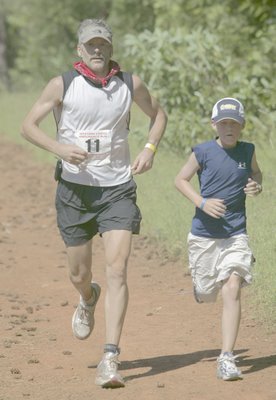 (Like father, like son - Tim and Austin Tweitmeyer at the 2005 Western States)
(Like father, like son - Tim and Austin Tweitmeyer at the 2005 Western States)
Leave your watch at home. The first time at WS it'’s very easy to get caught up in all the energy and hype around the race. That tends to carry over into the race and some early strategy mistakes are common.
The best training is to pace someone the year before planning to run the event. Along with that, attend the Memorial Weekend training camp. It's extremely important to see the course before the race.
I see that you're also a 26-time finisher of the American River 50. Any tips you would like to share about the course?
American River is an interesting course. Most local people don'’t like it because of the bike trail. We run it all the time and it can get boring as it'’s mostly flat. Personally, I'd rather be on the trail, but the bike trail is about as good as it gets if you have to be on pavement.
The people that run the best at AR are those that save some power and energy for the trail between Granite Bay and Rattlesnake Bar. It'’s a very choppy, rocky, rooted ten miles of trail that take a lot of focus. There are no long climbs or grades, but the trail twists and turns and it's very difficult to get momentum. There's just a lot of starting and stopping, and after running a 30, not too many runners are strong to push through all that irregularity.
Of course, the finish is always a thrill. It'’s more than three miles and mostly all uphill. After running 47 miles it would be nice to have a downhill finish, but this is one of the toughest. Over the years, I'’ve seen some real horror stories on that road climb where people were cramping and having a hard time making forward progress. It doesn'’t help that you can see the finish line with over a mile and a half to go.
The good part is that there will be 500 other runners out there to share the trail with, so you'’ll definitely have some company for the misery.
You were recently elected as the President of the Western States Association. What does that entail? Will you be running the race again in 2006?
My role as president is mostly in planning and running the board meetings. Those meetings are where most of the decisions are made about how the event is managed as well as where all the government, community, and trail discussions take place. The WS 100 is a year-round effort as we spend a lot of the fall working on non-race activities like trail maintenance, meetings with the US Forest Service, and California State Parks people, talking with sponsors, discussing medical studies and procedures, and making small changes to the event (like this year with the new trail). I also work with Greg Soderlund, the WS race director, on some of the tactical issues of the race (radio communications, river crossing logistics, sweep riding, etc).
I'’m planning to run in 2006 although
that'’ll be my last run at WS for awhile, maybe ever (note - Tim finished the 2006 WS 100 in under 24 hours, his 25th sub-24 hour finish). In 2007, I want to work the race and see the event from the administration side. I'’d like to spend the day with Greg Soderlund, the race director, just to see what goes on behind the scenes.
 (Tim Twietmeyer on the Western States trail; photo courtesy of RunnersWeb)
(Tim Twietmeyer on the Western States trail; photo courtesy of RunnersWeb)
Nah. I think the standard buckle is plenty of reward for finishing and so does Runner'’s World as they voted it the best running award of any event. (Note: Tim was presented with a 25-time finisher buckle at the 2006 WS 100)
A few quick questions about your training. What does a typical training week look like for you? Do you do any races outside of WS and the AR50?
When I'm training hard for something like WS, I'’ll run a 50-mile training run or race every three or four weeks. On average, I'm putting in somewhere between 60 and 80 miles and probably close to half of that mileage on one day on the weekend. My biggest month in my career was a May training for WS and I put in 350 miles. I've never been a really high mileage guy, but I never get too far out of race shape.
Over the years, I've run a bunch of other races. I've done a bunch of Cool races (
Way Too Cool and Canyon Crawl). I'’ve run a whole bunch of Cal 50's. As for 100's, I've done Leadville, the Eagle in Canada, and the
Tour of Mont Blanc (155K) once. I'’m planning to go back to Mont Blanc later this year.
What are your favorite foods/snacks? I heard somewhere that you go the last 20 miles of WS on nothing but flat coke and M&MÂ’s -– is that true?
Yes, in general that'’s true. Occasionally I'll choke down a cup of soup at one of the later aid station, but mostly I alternate between Coke and Code Red Mountain Dew. I just have a hard time getting much food down the hatch after about 70 miles. Those two things (soda and M&M'’s) seem to be enough to keep the boiler happy and get me to the finish line.
Do your wife or kids enjoy endurance sports too?
No, my wife is looking forward to my retirement from Western States. Occasionally we joke about Western States as being "the other woman". My youngest son, Austin, takes the most interest in my running. He's more of a mountain biker, but he enjoys being on the trail as much as I do. He's paced me through Foresthill and will run with me from Robie this year.
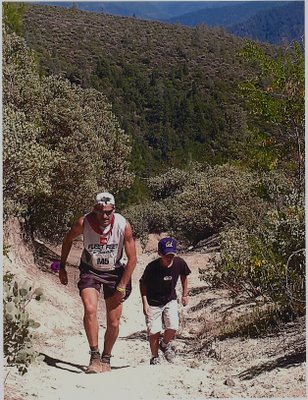 (Tim and his son, Austin, taking the hills at the 2005 Western States)
(Tim and his son, Austin, taking the hills at the 2005 Western States)
It's an ongoing battle to find the right balance. Since I’'ve never been a high mileage guy, I have been able to stay home a bit more. I try not to get too far out of shape so that I don't have to invest a bunch more time getting tuned back in. I discussed this with a colleague one day and he (Max Baucus, US Senator) had the best description as he called it the Domestic Tranquility Index. Sounds like a government calculation, but it generally describes the bank you have available to leave the family for a 10-hour training run. The index goes way down until you take everyone out to dinner or bring home flowers.
Thanks for a great interview, and best of luck in your 25th Western States!
SD
PS - Tim is sponsored by North Face, and you can find another great interview with him on their site. He also did a podcast interview with EnduranceRadio in Nov, 2005.
 (Brian Morrison collapsing at the finish, later to be disqualified; photo courtesy of Kurt Bertilson)
(Brian Morrison collapsing at the finish, later to be disqualified; photo courtesy of Kurt Bertilson) (Graham Cooper (with kids), unknowingly winning the 2006 Western States 100; photo courtesy of Kurt Bertilson)
(Graham Cooper (with kids), unknowingly winning the 2006 Western States 100; photo courtesy of Kurt Bertilson)

